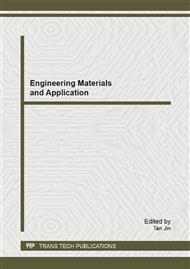[1]
Nishant Singh, Johnson John H, Parker Gordon G, et a1.Vehicle Engine After treatment System Simulation(VEASS)Model:Application to controls Design Strategy for Active Regeneration of a Catalyzed Particulate Filter[C].SAE Paper 2005-01-0970.
DOI: 10.4271/2005-01-0970
Google Scholar
[2]
Hu Yi, Li Mengliang, Li Jun, et al. An experimental study on the performance of exhaust after treatment Devices in Diesel Vehicle [J]. Automotive Engineering, 2010, 32(5): 451-454 (in Chinese).
Google Scholar
[3]
Ye S., Yap H. Kolaczkowski T., et al. Catalyst light-off, experiments on a diesel oxidation catalyst connected to a diesel engine-Methodology and techniques. [J] Chemical Engineering Research and Design, 2012, 90(6): 834-845.
DOI: 10.1016/j.cherd.2011.10.003
Google Scholar
[4]
Ohyaraa. N, Nakanishi. T,Shigeki Daido.New Concept Catalyzed DPF for Estimating Soot Loadings from Pressure Drop[C].SAE Paper 2008-01-0620.
DOI: 10.4271/2008-01-0620
Google Scholar
[5]
Wurzenberger Johann C.Simulation of Exhaust Gas After treatment Systems-Thermal Behavior During Different Operating Conditions[C].SAE Paper 2008-01-0865.
DOI: 10.4271/2008-01-0865
Google Scholar
[6]
Kladopoulou, E. A., Yang, et al. A Study describing the performance of diesel particulate filters during Loading and regeneration- A lumped parameter model for controls applications, SAE Paper 2003-01-0842.
DOI: 10.4271/2003-01-0842
Google Scholar
[7]
Li Zhonghua, Du Chuanjin. The analysis and study of the regeneration technology for diesel particulate filter [J]. Diesel Engine, 2006, (1): 46-48 (in Chinese).
Google Scholar
[8]
Ming Zheng, Dong Wang and Graham T.Reader.Boundary Layer Enhanced Thermal Recuperation for Diesel Particulate Filter Regeneration under Periodic Flow Reversal Operation[C].SAE Paper 2005-01-0951.
DOI: 10.4271/2005-01-0951
Google Scholar
[9]
Al-Qurashi, K. and A.L. Boehman. Impact of exhaust gas recirculation (EGR) on the oxidative reactivity of diesel engine soot [J]. Combustion and Flame, 2008. 155(4): 675-695.
DOI: 10.1016/j.combustflame.2008.06.002
Google Scholar
[10]
Sheng, C., Char structure characterised by Raman spectroscopy and its correlations with combustion reactivity [J]. Fuel, 2007, 86(15): 2316-2324.
DOI: 10.1016/j.fuel.2007.01.029
Google Scholar
[11]
Sadezky, A., H. Muckenhuber, et al. Raman micro spectroscopy of soot and related carbonaceous materials: Spectral analysis and structural information [J]. Carbon, 2005, 43(8): 1731-1742.
DOI: 10.1016/j.carbon.2005.02.018
Google Scholar
[12]
Cuesta A, Dhamelincourt P, Laureyns J, et al. Raman microprobe studies on carbon materials [J]. Carbon, 1994, 32(8): 1523–1532.
DOI: 10.1016/0008-6223(94)90148-1
Google Scholar
[13]
Jawhari T, Roid A, Casado J. Raman spectroscopic characterization of some commercially available carbon black materials [J]. Carbon. 33(1995): 1561–1565.
DOI: 10.1016/0008-6223(95)00117-v
Google Scholar
[14]
Dippel B, Heintzenberg J. Soot characterization in atmospheric particles from different sources by NIR FT Raman spectroscopy [J]. Journal of Aerosol Science. 1999, 30(Supplement 1): S907-S908.
DOI: 10.1016/s0021-8502(99)80464-9
Google Scholar
[15]
Sze S K, Siddique N, Sloan J, et al. Raman spectroscopic characterization of carbonaceous aerosol [J]. Atmospheric Environment. 2001, 35: 561-568.
DOI: 10.1016/s1352-2310(00)00325-3
Google Scholar
[16]
Andrea Carlo Ferrari and John Robertson. Raman spectroscopy of amorphous, nanostructured, diamond-like carbon, and nanodiamond. Philosophical Transactions of the Royal Society A [J]. 2004, 362: 2477-2512.
DOI: 10.1098/rsta.2004.1452
Google Scholar
[17]
Richard Nyquist. Interpreting Infrared, Raman, and Nuclear Magnetic Resonance Spectra [M]. Elsevier, 2001. 62-567.
Google Scholar
[18]
Yoshida, A., Y. Kaburagi, and Y. Hishiyama. Full width at half maximum intensity of the G band in the first order Raman spectrum of carbon material as a parameter for graphitization. Carbon, 2006. 44(11): 2333-2335.
DOI: 10.1016/j.carbon.2006.05.020
Google Scholar
[19]
Ohno K., Taoka N., Ninomiya T, et al. Sic Diesel Particulate Filter Application to Electric Heater System. SAE Paper, 1999, 1999-01-0464.
DOI: 10.4271/1999-01-0464
Google Scholar
[20]
Min J. S., lee C. Q., Kim S. H., et al. Development and Performance of Catalytic Diesel Particulate Filter Systems for Heavy—Duty Diesel Vehicles, SAE Paper, 2005,2005-01-0664.
DOI: 10.4271/2005-01-0664
Google Scholar


